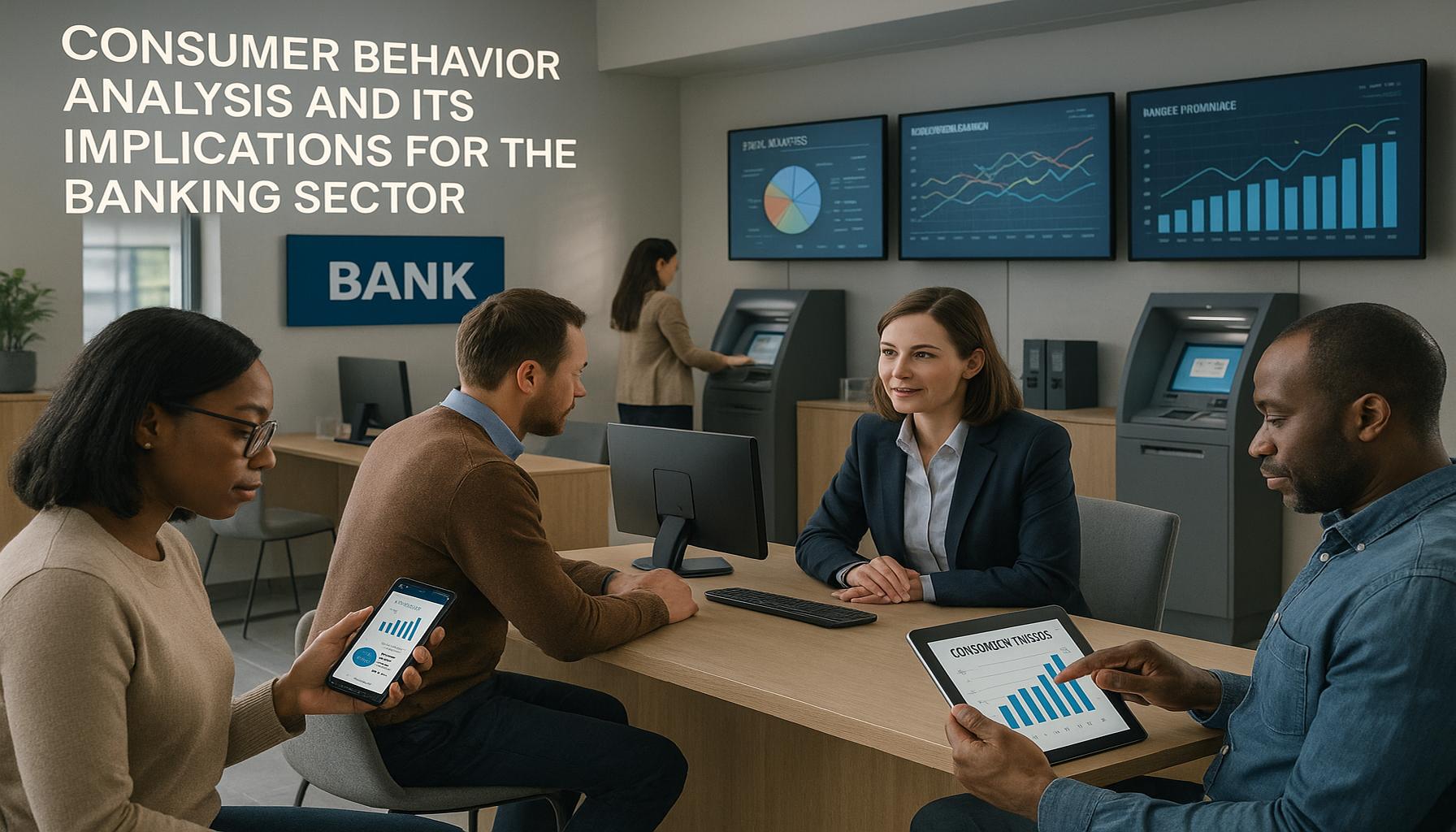Analysis of Changes in Consumer Behavior and Their Implications for the Banking Sector

The Changing Dynamics of Consumer Behavior in Banking
Over the past few years, consumer behavior within the banking sector has undergone a significant transformation. This evolution is largely driven by advancements in technology, changes in societal values, and variations in the economic landscape. For financial institutions, staying attuned to these trends is not just beneficial but essential for adapting their services and offerings to meet the evolving needs of their clientele.
Key Trends Influencing Consumer Behavior
Several prominent trends have emerged that vividly illustrate this shift in consumer behavior:
- Digital Adoption: The rise of online banking has dramatically changed how consumers manage their finances. A report from the American Bankers Association highlighted that 73% of Americans prefer online banking due to its convenience. Customers can check their balances, transfer money, and manage accounts from the comfort of their homes, often via their smartphones or tablets.
- Personalization: Today’s customers seek personalized financial solutions tailored to their unique circumstances. For instance, many banks are now offering customizable savings plans that adjust based on an individual’s spending habits and financial goals. Consumers appreciate when banking services consider their personal history and preferences, leading to increased satisfaction and loyalty.
- Value Consciousness: With economic uncertainty impacting disposable income, more consumers are placing a premium on cost-effectiveness. They tend to scrutinize banking fees and want transparent pricing. For example, customers are increasingly opting for banks that provide no-fee checking accounts and clear information regarding any charges incurred.
Adapting to Meet Consumer Expectations
These shifting consumer behaviors present both challenges and opportunities for banks. To remain relevant and competitive, financial institutions must prioritize innovation and proactively adapt to these trends by:
- Enhancing Digital Experiences: Providing seamless access to online services and robust mobile banking applications is crucial. This includes creating user-friendly interfaces and offering features like mobile check deposits and real-time transaction alerts, allowing customers to manage their finances efficiently.
- Improving Customer Engagement: Building strong relationships through personalized communications can reinforce customer loyalty. Banks can use targeted marketing and tailored advice based on consumer behaviors and preferences, creating a more relevant banking experience.
- Adopting New Technologies: By leveraging artificial intelligence (AI) and data analytics, banks can gain valuable insights into customer preferences. This technology enables banks to predict consumer needs, offering them services before they even have to ask—thus enhancing the overall customer experience.
The Path Forward
As we further explore these crucial trends, it becomes clear that understanding and responding to consumer preferences will shape the future of banking. By actively engaging with these emerging behaviors, banks not only position themselves for survival but also open doors for growth and innovation in a continually evolving marketplace. In this dynamic environment, being responsive and adaptable is key to nurturing customer relationships and fostering long-term success.
Understanding the Impacts of Digital Transformation
The shift toward digital banking has been one of the most profound changes in consumer behavior in recent years. As technology becomes more ingrained in daily life, consumers now expect banks to evolve alongside their digital habits. For many, the traditional branches are becoming less relevant than mobile apps and online platforms, which provide instant access to financial services. This transformation has led banks to focus significantly on enhancing their digital capabilities, ensuring that they can meet the growing demand for online resources.
A notable aspect of digital transformation is the impact of social media and online reviews. Customers heavily rely on the opinions of others when making financial decisions. A survey by Deloitte revealed that over 80% of respondents considered online reviews as influential when choosing a banking provider. This trend underlines the importance of maintaining a positive online presence. Banks need to engage with their customers through various digital channels, addressing concerns promptly and showcasing positive experiences to build trust and satisfaction.
The Importance of Personalization in Banking
As consumers become accustomed to personalized experiences offered by tech giants like Amazon and Netflix, they also expect the same level of personalization from banks. This desire for a tailored financial relationship is driving banks to adopt data-driven strategies. By utilizing data analytics, banks can gain insights into individual customer needs and preferences. This technology enables them to provide personalized products, targeted offers, and proactive advice.
For instance, if a customer frequently travels abroad, banks can alert them to travel-friendly debit cards with waived foreign transaction fees or suggest protections against international fraud. Such tailored offerings not only increase customer satisfaction but also enhance loyalty. Research indicates that 70% of consumers are more likely to choose a bank that personalizes their services, highlighting the vital role of personalized banking in today’s financial landscape.
Cost Sensitivity and Transparency
The current economic climate has led many consumers to become increasingly cost-conscious. With rising living expenses and inflation, individuals are scrutinizing their financial decisions more closely than ever. As a result, transparency regarding fees and services has emerged as a key factor in consumer selection processes. Many customers are opting for banks that offer no-cost services or minimized fees, particularly for essential accounts like checking and savings.
This shift means that banks must be transparent in their pricing models to retain and attract customers. Clearly communicating any potential fees and ensuring that customers are aware of the costs associated with their accounts can foster consumer trust. In fact, a study by J.D. Power found that transparency in fees can significantly enhance customer satisfaction levels, positioning banks as trustworthy institutions in the eyes of their clientele.
In summary, the changing consumer behavior marked by digital adoption, personalized services, and heightened cost sensitivity imposes new challenges and opportunities for banks. Understanding and adapting to these trends will be essential for financial institutions aiming to thrive in an increasingly competitive market. Moving forward, analyzing these shifts is not merely an operational necessity; it is crucial for building lasting relationships with customers and ensuring long-term success in the banking sector.
The Role of Financial Education and Empowerment
With the rise of financial literacy concerns among consumers, financial education has emerged as a pivotal factor influencing modern banking habits. Many individuals, particularly younger generations, are actively seeking knowledge around managing finances, investments, and savings. This growing appetite for financial understanding is prompting banks to step up their educational initiatives. Institutions are beginning to offer financial literacy programs and digital resources that help customers navigate their financial journeys confidently.
For example, banks may provide online webinars on budgeting, saving for retirement, or understanding credit scores. Furthermore, many financial institutions have begun integrating educational content directly into their mobile apps, making it accessible to users at their fingertips. The challenge for banks lies in balancing these educational efforts with their product promotions. Research indicates that consumers who utilize educational resources from their banks are far more likely to develop a stronger financial relationship with them, leading to increased product adoption and loyalty.
The Emergence of Sustainable Banking Practices
As societal values evolve, consumers are not just looking for competitive rates and services; they are also increasingly interested in the sustainability practices of their financial institutions. Awareness around climate change and social responsibility influences the banking choices made by consumers. A growing number of customers prefer banks that showcase a commitment to environmental sustainability and ethical lending practices. In fact, studies show that nearly 60% of millennials and Gen Z consumers consider the ethical implications of their banking choices.
To align with this shift, many banks have begun to adopt green banking initiatives. This may involve offering loans with lower interest rates for eco-friendly projects, such as solar panel installations or electric vehicles. By highlighting these sustainable initiatives, banks can attract environmentally conscious consumers who resonate with their practices and values. Establishing a reputation as a bank of choice for socially responsible individuals will further enhance customer loyalty and potentially widen the client base.
The Influence of Mobile Payment Technologies
The rise of mobile payment technologies has significantly altered how consumers interact with their banks. The convenience of mobile wallets like Apple Pay, Google Pay, and others has reshaped payment habits, with many preferring these digital solutions over traditional payment methods. According to a survey by Statista, the percentage of Americans using mobile payment platforms surged to over 30% in recent years, showcasing a clearly defined preference for cashless transactions.
This trend brings both challenges and opportunities for banks. To remain relevant, financial institutions need to not only accommodate these technologies by integrating them into their offerings, but also provide enhanced security measures to protect consumers against fraud. Offering seamless transactions through mobile apps and ensuring that customers feel secure while using these platforms will be crucial. As a result, banks investing in innovative payment solutions and security features are likely to attract and retain a tech-savvy customer base.
In conclusion, the evolving landscape of consumer behavior—driven by a desire for financial education, sustainability, and digital payment solutions—presents banks with both challenges and opportunities. Adapting to these consumer trends is not merely about staying competitive; it involves creating a forward-thinking banking environment that resonates with the values and habits of today’s consumers. Financial institutions that embrace these changes are well-positioned to foster relationships built on trust and satisfaction. Understanding these shifts will ultimately guide banks toward new strategies that align with the expectations of their customers.
Conclusion
As we can see, the shift in consumer behavior is reshaping the banking landscape significantly. The increasing demand for financial education highlights the importance of empowering customers with knowledge, enabling them to make informed decisions regarding their finances. Banks that focus on educational initiatives not only strengthen customer relationships but also enhance their overall brand loyalty.
Moreover, the emphasis on sustainable banking practices reflects a broader societal shift towards responsibility and ethics. Consumers are actively choosing financial institutions that align with their values, prompting banks to adopt greener practices while exploring new avenues, such as supporting eco-friendly projects. This alignment fosters trust and creates a loyal customer base that appreciates a bank’s commitment to making a positive impact.
Lastly, the rise of mobile payment technologies has transformed how consumers engage with banking services. Financial institutions must continuously innovate, ensuring that their digital offerings meet modern expectations for convenience and security. By investing in technology and understanding consumer preferences, banks can not only attract tech-savvy customers but also stay ahead in a competitive market.
In conclusion, the banking sector must remain agile and responsive to these evolving consumer trends. By prioritizing financial literacy, sustainability, and digital innovation, banks can cultivate lasting relationships with their customers. This alignment will not only fulfill the current demands but also pave the way for future growth and success in an increasingly dynamic financial landscape.
Related posts:
The importance of revenue diversification for sustainable business
The Impact of Artificial Intelligence on Investment Decisions in 2024
How to Prepare Your Business for Market Fluctuations
Investment Trends in Emerging Sectors: What to Expect in 2025
The growth of e-commerce and its impact on the economy
The Role of Cryptocurrencies in New Financing Structures

James Carter is a financial writer and advisor with expertise in economics, personal finance, and investment strategies. With years of experience helping individuals and businesses make complex financial decisions, James offers practical insight and analysis. His goal is to give readers the knowledge they need to achieve financial success.